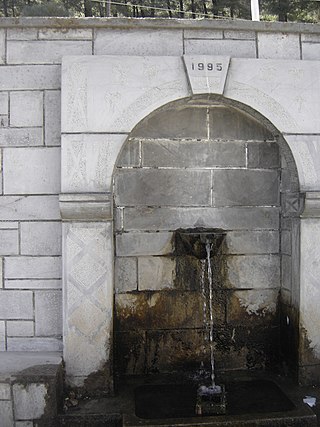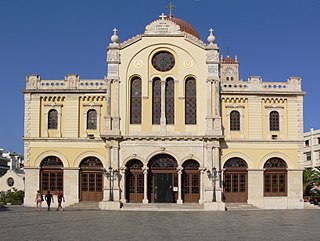
Crete is the largest and most populous of the Greek islands, the 88th largest island in the world and the fifth largest island in the Mediterranean Sea, after Sicily, Sardinia, Cyprus, and Corsica. Crete rests about 160 km (99 mi) south of the Greek mainland, and about 100 km (62 mi) southwest of Anatolia. Crete has an area of 8,450 km2 (3,260 sq mi) and a coastline of 1,046 km (650 mi). It bounds the southern border of the Aegean Sea, with the Sea of Crete to the north and the Libyan Sea to the south.

Heraklion or Iraklion is the largest city and the administrative capital of the island of Crete and capital of Heraklion regional unit. It is the fourth largest city in Greece with a population of 211,370 according to the 2011 census. The population of the municipality was 177,064.

Myrtos is a coastal village in the west of the municipality of Ierapetra, in the Regional Unit of Lasithi on the Greek island of Crete. It is located 50 km (31 mi) from Agios Nikolaos and 15 km (9.3 mi) from Ierapetra, on the road to Viannos. A little to the west of the village is the iconic conical Kolektos mountain. Myrtos is situated on the Libyan Sea. The patron saint of the village is Saint Anthony. The population of the village in 2010 was approximately 600 people.

The University of Crete is a multi-disciplinary, research-oriented institution in Crete, Greece, located in the cities of Rethymno and Heraklion, and one of the country's most academically acclaimed and reputable universities.

Psychro Cave is an ancient Minoan sacred cave in Lasithi plateau in the Lasithi district of eastern Crete. Psychro is associated with the Diktaean Cave, one of the putative sites of the birth of Zeus. Other legends place Zeus' birthplace as the Idaean Cave on Mount Ida. According to Hesiod, Theogony, Rhea gave birth to Zeus in Lyctus and hid him in a cave of Mount Aegaeon. Since the late nineteenth century the cave above the modern village of Psychro has been identified with the Diktaean Cave, although there are other candidates, especially a cave above Palaikastro on Mount Petsofas.

The Heraklion Archaeological Museum is a museum located in Heraklion on Crete. It is one of the greatest museums in Greece and the best in the world for Minoan art, as it contains by far the most important and complete collection of artefacts of the Minoan civilization of Crete. It is normally referred to scholarship in English as "AMH", a form still sometimes used by the museum in itself.
The Centre for Technological Research of Crete (CTR-Crete) in Heraklion was founded according to the presidential decree No. 143/Φ.Ε.Κ. 123/20-6-2001 and is under the supervision and financing of the Ministry of National Education and Religious Affairs (Greece). It is a Private Legal Body, self-governed within the framework of articles 11 and 12 par. 1 of 1771/1998 Greek law and its internal regulation. There are 55 staff member, including 25 research scientists, 15 assistant researchers, and 15 associate researchers. CTR-Crete is affiliated with the Technological Educational Institute (TEI) of Crete and includes eight Sectors of Technology Transfer and Research operating in all four regional units of Crete.

Chryssolakkos means the "Pit of gold". This is where the ancient necropolis in Malia, an ancient Minoan town in Crete, Greece is located. As well as the famous Malia Pendant, it is commonly thought that the so-called Aegina Treasure of Minoan jewellery in the British Museum was excavated here by local people in the 19th century.

The Historical Museum of Crete is a museum in Heraklion, Crete. It was founded by the Society of Cretan Historical Studies in 1953 and was originally housed in the former home of Minos Kalokairinos. The museum has since been expanded with a modern wing.
The Museum of the Battle of Crete and the National Resistance is a municipal historical museum dedicated to the defense of Crete during WWII and the popular resistance of Crete. It is located near the Heraklion Archaeological Museum in the city of Heraklion on the island of Crete, Greece.
The Museum of Cretan Ethnology is a museum in Voroi, in the municipal unit of Faistos, Heraklion regional unit, southern Crete, Greece. Established as an institution in 1973, the museum was built under the French architect Georges Henri Rivière, the creator of the Musée National des Arts et Traditions Populaires of Paris, between 1977 and 1982 under sponsorship of the Greek Ministry of Culture and opened formally in 1988. However, it has been an important centre of research since 1980 in studying the civilizations of Crete from 1000 to the present day. The museum contains artifacts found all over Crete from the Minoan period, the Archaic and Byzantine, although a significant part of the collection is from the period of Turkish occupation. The museum is particularly rich in items related to agriculture, stock breeding, pottery, basketry, wood carving, architecture and music and dancing.

Kato Symi is a small historic village of Crete, in Heraklion regional unit, 31 km (19 mi) from Ierapetra and 74 km (46 mi) from Heraklion city. Today it belongs to Viannos municipality and borders the Ierapetra municipality. It lies about 780 m (2,560 ft) above sea level, south of Mount Dikti in a verdant mountainous area, which is probably the most wooded of Crete. Near the village, at an altitude of 1,200 m (3,900 ft), lies the ancient sanctuary of Hermes and Aphrodite. It is dated from the middle Minoan period and had been used for worship for more than 1,000 years. Kato Simi has been destroyed three times, by Arabs, Turks and finally by the German army in World War II, when it was the center of resistance of the Viannos–Ierapetra area against the Nazi occupying forces.

Theodoros Vardinogiannis Stadium is a stadium in Heraklion, Crete, Greece. It was built in 1951 as the home stadium of OFI Crete. The stadium is commonly known by its nickname, Yedi Kule.
Greek National Road 97 is a national highway on the island of Crete, Greece. It connects Heraklion with Agia Galini on the south coast, via Moires.

Myrtia is a village in the northern part of the municipal unit Nikos Kazantzakis, Crete, Greece. It is 15 km from Heraklion. It is situated at an altitude of 365 meters from the sea. It borders with the municipal unit of Episkopi and the municipality of Heraklion, and the villages Astrakoi and Agies Paraskies. It has a population of 560 inhabitants, according to the 2011 census.

Sisi, or Sissi is a small Greek resort in the municipal unit Vrachasi, Lasithi, Crete. It is situated on the north coast, 6 km northwest of Vrachasi and 6 km east of Malia, 22 km northwest of Agios Nikolaos and 35 km east of Heraklion.

The Agios Minas Cathedral is a Greek Orthodox Cathedral in Heraklion, Greece, serving as the seat of the Archbishop of Crete. Ιt is dedicated to Saint Menas the martyr and wonderworker, who is the patron saint of Heraklion.

The Church of Crete is an Eastern Orthodox church, comprising the island of Crete in Greece. The Church of Crete is semi-autonomous (self-governing) under the jurisdiction of the Ecumenical Patriarchate of Constantinople.The current archbishop of Crete is Eugenios II.

The Museum of El Greco is located on the edge of the village of Fodele in Crete, west of the city of Heraklion. It celebrates the mannerist painter El Greco, who grew up in the village.
Agios Myronas is a village in the Heraklion regional unit of Crete, Greece named for Saint Myron of Crete. In 2011, its population was 612.
















